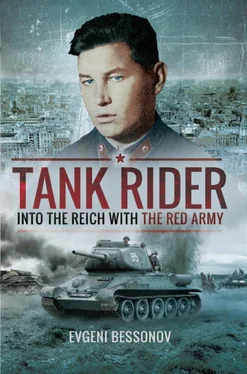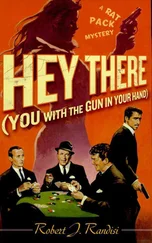The platoon leader of the mortar company, Lieutenant Novozhilov, was killed in that fight. The Germans were about to capture the mortars, and then Novozhilov ordered his soldiers to withdraw to another position, while he himself stayed and covered their retreat with a machine-gun – mortar crews had one just in case. The Germans set the house, from which he fired, on fire, but he continued to fire from that house until he himself burnt to death. This is how Lieutenant Sergei Vasilievich Novozhilov died on 28 March, 1944, a brave and cheerful officer. He sacrificed his life to save the lives of soldiers from his company. The Germans did not advance any further after Sergey’s death, and, on the contrary, they abandoned a couple of huts next to the burnt-down house. We had to fold the left flank of the company towards the enemy, in order to keep them under our fire, and in that moment they almost got me – the bullet just scratched the skin on my side. Apparently, a German had fired an explosive bullet at me, and as a result for a long time I had a black stain on my right side.
On one of the days in late March 1944 a heavy snowfall set in, and it continued the whole night. I slept in my foxhole like a baby, covered by two German blankets. In the morning, when I woke up, it turned out that the foxhole was full of snow. There was so much snow that my soldiers literally had to dig me out. At the same time, Chernyshov was in the house, in the warmth – they had a stove there. He did not care to invite me to get warm, even though we were both platoon leaders. As soon as he was appointed company leader, his attitude toward me and to other officers of the platoon – Shakulo and Gavrilov – changed. I did not visit him in that hut, always stayed with the soldiers, had my meal with them, but I really wanted to have some hot soup or schi , or just some tea.
The Germans, under cover of the blizzard, abandoned their positions and disappeared. So, when we finally got out from the snow, the guys told me that there were no Germans opposing us. It was only then that we went into the huts to cook something hot. We were already tired of chocolate, cookies and canned food, as well as wine, too.
The enemy bypassed the town of Kamenets-Podolsk and moved to the west, abandoning cars and other vehicles on the roads in the blizzard. I have never seen so many burnt or abandoned vehicles. From the east, from Vinnitsa, the army units of the first Ukrainian front chased Germans towards us, but we did not have enough resources to stop the enemy at Kamenets-Podolsk and fully encircle him, as happened in Stalingrad. Disregarding their losses, abandoning vehicles that were stuck because of lack of fuel or mud, the Germans broke through to the west. The fighting was bloody and heavy. I remember that we used to find Soviet propaganda leaflets signed by Marshal G. K. Zhukov, calling for German soldiers to surrender, as they were surrounded and were to be destroyed if they did not lay down their weapons. It is indeed a pity that we could not repeat the Stalingrad scenario. At the same time, we threw the Germans far to the west.
As Lieutenant Petr Shakulo told me after his return, he was in a medical platoon in the small town of Orinin, near to Kamenets-Podolsk. The HQ of our 6th Guards Motorized Corps was also stationed there under General Akimov. Retreating westwards, the Germans tried to capture Orinin. Even wounded soldiers that could still hold weapons had to fight to repel the German attacks. The battle lasted for several hours and the outcome was uncertain until several JS-2 tanks arrived to assist the besieged troops. As a result, the German tanks were destroyed and the infantry scattered, some surrendered. This is how 100 wounded and the Corps HQ were rescued.
The battles for Kamenets-Podolsk were over. Some time in early April general army units arrived from the east.
THE BRIDGEHEAD AT THE RIVER STRYPA

The Commander in Chief expressed his gratitude for the liberation of Kamenets-Podolsk to the soldiers of the Brigade in his Order of the Day of 27 March, 1944. Our Brigade and some other units of the 4th Tank Army received the honorary title of ‘Kamenets-Podolsk’, the full of name of the Brigade becoming ‘49th Mechanized Kamenets-Podolsk Brigade’, while its commander, Petr Nikitich Turkin, was promoted to the rank of Colonel.
The Brigade again received an order to advance to the west, and drive out the enemy from our land. After a blizzard that lasted two days, there was deep snow on the roads and in the fields, sometimes with snowdrifts. The battalion again mounted tanks with the aim of chasing the enemy, to prevent the possibility of his consolidating positions on good defensible grounds. The weather improved, the sky cleared of clouds, the sun shone and snow melted away. It grew warmer. We encountered the enemy in some places, but the Brigade successfully defeated any German attempt to stop us. We did not have many tanks left, and even those that remained had already used up their engine lifetime and were constantly breaking down. The tank that I was on with my soldiers also broke down. After a day-long stop in a village (we were already in the Western Ukraine), our tank stopped and would not move on. The battalion commander ordered me to stay with the tank and wait for it to be repaired. A day passed by and in the morning the tank crew told us that the breakdown was serious and we were stuck for a long time. I decided not to wait for the completion of the repairs, but to catch up with the battalion on foot. I thought that I would fall under suspicion of deliberate avoidance of fighting. It took us a couple of days to catch up with the battalion. A huge mass of our troops from different units of the front marched westwards, and no one could tell me where our Brigade had gone. At a crossroads I saw a sign with an arrow saying ‘Turkin’s unit’. We followed the sign. Almost every unit used such signs in that period of time, in order to prevent soldiers from wandering around on the roads of the war looking for their units. One afternoon, I think, on 12 April, I found my battalion: it had been reduced almost to nothing. We had a mission to complete, and before my arrival the battalion only had the 2nd company with ten to fifteen men, or maybe fewer. Only battalion HQ remained more or less intact, but it also had some losses. Battalion commander Kozienko, and zampolit Gerstein and chief of battalion’s staff Belan were happy to see me – I had at least 20 or 25 soldiers with me, all that remained of 1st and 2nd companies. Company leader Chernyshov and his staff were not in the battalion and no one knew where he was. Having fallen behind with a broken tank, the company commander only showed up some three days later.
Once with the battalion we got a hot meal, which we had not had for a long time – we received both the first and the second course; I remember this quite well. Only two officers were present in the battalion at that time – Junior Lieutenant Alexei Belyakov with the 2nd company and me. The battalion had a total strength of 32 to 35 men, or as they would put it, bayonets. The battalion’s artillery battery and mortar company were missing, the submachine-gun platoon, machine-gun company, anti-tank rifle company, all were missing. All these units were lost in battle and destroyed by enemy air force. Officers of the artillery battery showed up a bit later – Senior Lieutenant Kashintsev, Lieutenants Harmakulov and Isaev, Lieutenant Zaitsev from the mortar company, Lieutenants Volkov and Karpenko from the machine-gun company. I think they all arrived without their equipment (45 mm guns, 82 mm mortars, heavy machine-guns) and with just a few soldiers. The 2nd and the 3rd battalions of our Brigade also suffered significant losses, also mainly from air raids.
Читать дальше














